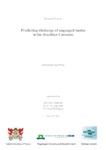Use este identificador para citar ou linkar para este item:
http://www.alice.cnptia.embrapa.br/alice/handle/doc/1070128Registro completo de metadados
| Campo DC | Valor | Idioma |
|---|---|---|
| dc.contributor.author | Agerbeek, S. | pt_BR |
| dc.date.accessioned | 2017-05-29T11:11:11Z | pt_BR |
| dc.date.available | 2017-05-29T11:11:11Z | pt_BR |
| dc.date.created | 2017-05-29 | pt_BR |
| dc.date.issued | 2016 | pt_BR |
| dc.identifier.citation | 2016. | pt_BR |
| dc.identifier.uri | http://www.alice.cnptia.embrapa.br/alice/handle/doc/1070128 | pt_BR |
| dc.description | Rapid population growth in urban areas resulting in an increase in cropland and the use of hydro-electric dams are seen as causes of ecological problems in Brazil, of which the non-sustainable use of water resource is a major concern. Small rivers have an important ecological and socio-economic function, but are more vulnerable to environmental changes. This thesis tests a downscaling methodology, using a regional and a local watershed SWAT model, for the Preto river and the Buriti Vermelho river respectively. The models are constructed using data from the Brazilian Cerrados. This methodology attempts to predict discharge in other ungauged small rivers by using calibrated parameters from the regional watershed model as input for a local watershed model. The downscaling methodology resulted in a local watershed model able to predict average monthly discharge values with a Nash-Suthcliffe Efficiency > 0.1. This means that the discharge simulation using this downscaling methodology of ungauged river basins is only slightly better than the observed average discharge. Secondly, the regional watershed model was also used to assess the impacts of various environmental changes, namely climate change, land-use change and a hydropower dam on discharge. Climate change simulations showed a decrease in baseflow of the Preto river for the worst case scenario, with an annual discharge decrease of 18.1% in 2100. Land-use change mainly resulted in a decrease in baseflow and the hydropower dam caused a decrease in yearly discharge, as well as a decrease in seasonal fluctuations in discharge. These results show that these three different scenarios severely impact total discharge, but mostly groundwater flow in the Preto river watershed. | pt_BR |
| dc.language.iso | por | pt_BR |
| dc.rights | openAccess | pt_BR |
| dc.subject | Mudanças climáticas | pt_BR |
| dc.subject | Distrito Federal | pt_BR |
| dc.subject | Rio Preto | pt_BR |
| dc.subject | Buriti Vermelho | pt_BR |
| dc.title | Predicting discharge of ungauged basins in the Brazilian Cerrados. | pt_BR |
| dc.type | Teses | pt_BR |
| dc.date.updated | 2017-05-29T11:11:11Z | pt_BR |
| dc.subject.thesagro | Hidrologia | pt_BR |
| dc.subject.thesagro | Bacia hidrográfica | pt_BR |
| dc.subject.thesagro | Cerrado | pt_BR |
| dc.subject.nalthesaurus | Watershed hydrology | pt_BR |
| dc.description.notes | Dissertação (Mestrado em Terra e Meio Ambiente) - Wageningen University, 2016. Lineu Neiva Rodrigues. | pt_BR |
| dc.format.extent2 | 79 f. | pt_BR |
| riaa.ainfo.id | 1070128 | pt_BR |
| riaa.ainfo.lastupdate | 2017-05-29 | pt_BR |
| Aparece nas coleções: | Tese/dissertação (CPAC)  | |
Arquivos associados a este item:
| Arquivo | Descrição | Tamanho | Formato | |
|---|---|---|---|---|
| 9.BasMasterThesisSebastiaanAgerbeek20160512.pdf | 4,16 MB | Adobe PDF |  Visualizar/Abrir |









